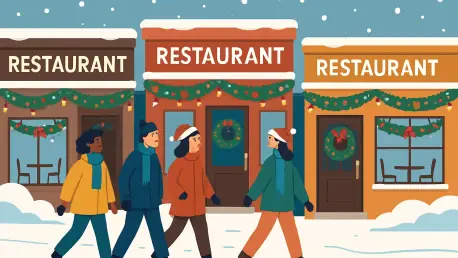Holiday dining turned into a high-stakes contest for attention and convenience as consumers sought comfort, speed, and celebration in the same order, and the brands that aligned menus, value, and digital access captured the biggest gains. With Thanksgiving through early winter compressing demand into a few defining dates, the market rewarded chains that paired craveable traditions with tight operational plans and timely promotions designed to lift frequency, basket size, and loyalty engagement.
Market Context And Scope
This analysis examines how national and regional restaurant chains competed for seasonal traffic by blending limited-time flavors, app- and kiosk-led exclusives, and value hooks engineered around marquee moments. The core dynamic centered on translating festive appetite into measurable visits while keeping operations predictable during demand spikes. That meant bundling family-style meals, prioritizing carryout and delivery flows, and shaping promotions that guided ordering into digital channels.
Importantly, the holiday window no longer functioned as a one-off event; it acted as a proving ground for broader shifts. Loyalty platforms, preorders, and dynamic promotions worked in tandem to smooth peaks, while turnkey bundles addressed at-home hosting needs. The season revealed how product design, pricing, and channel selection reinforced each other—and how brands that treated the calendar as a programmable asset outperformed those relying on generic discounts.
Demand Drivers And Category Momentum
Three engines drove traffic. First, digital exclusives reframed access and reinforced brand communities. Second, value spiked on select dates to create urgency and social relevance. Third, comfort-forward menus carried the storytelling load, while cultural range and dine-in experiences differentiated players competing for similar occasions. The interplay of these themes produced a market where novelty mattered, but predictable convenience decided repeat visits.
Moreover, service configuration—buffet, family meal, heat-and-eat, or standard carryout—proved as decisive as flavor. Chains that clarified pickup windows, improved packaging for travel, and set basket thresholds for delivery nudged guests toward profitable choices. As a result, operational simplicity became a growth lever, not just a cost guardrail.
Digital Exclusives As The New Demand Gate
App- and kiosk-only menus emerged as a velvet rope for loyalists and deal seekers alike. Taco Bell’s Fan Style Menu codified fan hacks into sanctioned builds, turning social behaviors into streamlined orders while capturing first-party data. By channeling customization through digital flows, operators raised check averages with add-ons, simplified forecasting, and reduced line friction. The result was stickier engagement that resonated beyond the season.
However, exclusivity required nuance. Gating too much risked fatigue and churn; offering too little diluted the value of joining. The best-performing models balanced visible savings with “insider” customization, layered limited windows to create urgency, and integrated upsell prompts that felt helpful rather than pushy. The strategic lesson was clear: access design was as important as the offer itself.
Date-Anchored Value And Eventized Promotions
Time-bound offers tied to cultural and culinary moments punched above their weight. Chipotle’s Thanksgiving Eve BOGO entrée connected savings to one of the busiest takeout nights, capturing on-the-go hosts and travelers. Teriyaki Madness leaned into National Chicken Teriyaki Day with a BOGO, free delivery, and a sweepstakes to compound reach and retention. Compared with evergreen discounts, these eventized promos drove urgency, focused staffing, and supported clean inventory plans.
The risk profile was manageable when operators enforced digital redemption, bundled add-ons, and limited redemption windows. These safeguards preserved margin while steering guests toward higher-value baskets. Over time, owning a date on the calendar created mental availability—consumers learned which brand to consider first when a particular craving or tradition surfaced.
Comfort Menus, Cultural Range, And Experiential Plays
Seasonal comfort remained the emotional anchor, but differentiation separated winners from also-rans. Tocaya’s Sweet Corn Tamales and Red Pozole delivered cozy, regional warmth through a modern Mexican lens. Perkins elevated scratch-made pies and turnkey Holiday Turkey Dinner Family Meals for hosting. Bad Daddy’s pushed indulgence with the Short Rib Stacker, Candy Cane Shake, and Chocolate OREO Crunch Cheesecake, while Nothing Bundt Cakes used peppermint and coconut as festive signposts. Each offer was familiar enough to invite trial yet distinctive enough to be remembered.
Experiential hospitality still mattered. Shoney’s Thanksgiving Day buffet—with a complimentary slice of pumpkin pie—reframed the holiday as an in-restaurant gathering, not just a transaction. Meanwhile, culturally distinct menus like the Nigerian “FRNDS from Lagos” lineup (Suya, Jollof Rice, Meat Pies) broadened appeal without undermining traditional flavors. The misconception that seasonal equals predictable gave way to a more durable truth: familiarity set the baseline, but cultural storytelling and service format created the edge.
Outlook, Projections, And Operating Implications
Looking ahead from the current season, personalization moved toward the center of holiday strategy. Expect AI-shaped offers in loyalty apps, “make it festive” modifiers, and dynamic pricing windows tied to local calendars—flight surges, school breaks, and even regional weather patterns. Pre-scheduled pickup and smaller-format ghost stations for holiday bundles signaled a push for smoother peaks, while closer carrier integrations aimed to protect product integrity during crunch periods.
Economic pressures kept value prominent, but with smarter guardrails: basket minimums, tiered perks, and BOGO-plus-add-on structures that raise contribution per order. Regulatory scrutiny around junk fees and data privacy encouraged clearer disclosures and tighter targeting. Cultural collaborations—global holiday features launched with operational playbooks—offered novelty that scaled without burdening crews.
Strategic Playbook For Operators
A calendar-first approach stood out: anchor one signature date—Thanksgiving Eve, early December, or New Year’s week—with a distinct value hook, then stack smaller offers around it to sustain momentum. Digital needed to be the front door, not an add-on. App and kiosk exclusives should simplify builds, guide upsells, and capture preorders for family meals to flatten peaks and stabilize kitchens.
Menu planning worked best when nostalgia and novelty coexisted. Pair pies, peppermint, and short rib with tamales, pozole, or Jollof to widen relevance without sprawl. Design promotions for profitable behavior—digital redemption, minimums, and daypart targeting—while ensuring flows remain staff-friendly. Finally, fortify dine-in experiences with buffets, chef-carved moments, or a small complimentary treat to signal hospitality and justify the trip.
Final Take
The season demonstrated that restaurants won holiday traffic by orchestrating comfort-forward menus, culturally resonant twists, digital exclusives, and date-timed value within a single operating system. Brands that treated the calendar as an asset, not a constraint, secured frequency gains and stronger baskets. The next steps were clear: formalize ownership of a key date, tighten digital access and personalization, and operationalize convenience through bundles, preorders, and packaging so the experience traveled well. Those moves set the stage for repeatable wins beyond the holidays and positioned operators to scale smartly when the next demand spike arrived.









